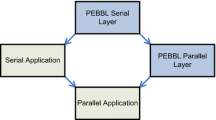Abstract
We designed TigerSwitch, a digital private branch exchange (PBX) implemented on an IBM PC-compatible platform, as an experiment in embedded system design. A telephone switching system is an interesting example of embedded system co-design because it combines a rich functionality with deadlines ranging from seconds to tenths of a millisecond. This paper uses design decisions from TigerSwitch to illustrate the difficulties faced in the partitioning and allocation of a system specification into an architecture: the critical performance paths may not be obvious from the initial specification, and it is often difficult to obtain the performance data required to allocate functions in the architecture.
Similar content being viewed by others
References
L. A. Baxter, P. R. Berkowitz, C. A. Buzzard, J. J. Horenkamp, and F. E. Wyatt. System 75: communications and control architecture. AT&T Technical Journal 64(1): 153–173, January 1985.
J. Bellamy. Digital Telephony. Second edition. John Wiley and Sons, 1991.
L. C. Eggebrecht. Interfacing to the IBM Personal Computer. Second edition. Sams, 1990.
J. M. Kasson. The ROLM Computerized Branch Exchange: An advanced digital PBX. IEEE Computer, pp. 24–31. June 1979.
Y.-T. S. Li and S. Malik. Performance analysis of embedded software using implicit path enumeration. In Proceedings, 32 nd Design Automation Conference, pp. 456–461. ACM Press, 1995.
C. L. Liu and J. W. Layland. Scheduling algorithms for multiprogramming in a hard-real-time environment. Journal of the ACM 20(1): 46–61, January 1973.
A. Mar, ed. Digital Signal Processing Applications Using the ADSP-2101 Family. Volume 1, Prentice Hall, 1992.
C. Y. Park and A. C. Shaw. Experiments with a program timing tool based on source-level timing scheme. IEEE Computer 24(5): 48–57, May 1991.
Texas Instruments. Digital Signal Processing Applications with the TMS 320 Family. 1986.
W. Wolf. Hardware-software co-design of embedded systems. Proceedings of the IEEE 82(7): 967–989, July 1994.
W. Wolf, A. Wolfe, S. Chinatti, R. Koshy, G. Slater, and S. Sun. TigerSwitch: A case study in embedded computing system design, in Proceedings, 1994 International Workshop on Hardware-Software Co-Design, IEEE Computer Society Press, 1994, pp. 89–96.
N. S. Woo, A. E. Dunlop, and W. Wolf. Codesign from cospecification. IEEE Computer, pp. 42–47, January 1994.
T.-Y. Yen and W. Wolf. Performance estimation of distributed embedded systems, in Proceedings, ICCD '95, IEEE Computer Society Press, 1995.
P. Zave. A compositional approach to multiparadigm programming. IEEE Software, pp. 15–25, September 1989.
Rights and permissions
About this article
Cite this article
Wolf, W., Wolfe, A., Chinatti, S. et al. Lessons from the design of a PC-based private branch exchange. Des Autom Embed Syst 1, 297–313 (1996). https://doi.org/10.1007/BF00209907
Received:
Accepted:
Issue Date:
DOI: https://doi.org/10.1007/BF00209907




